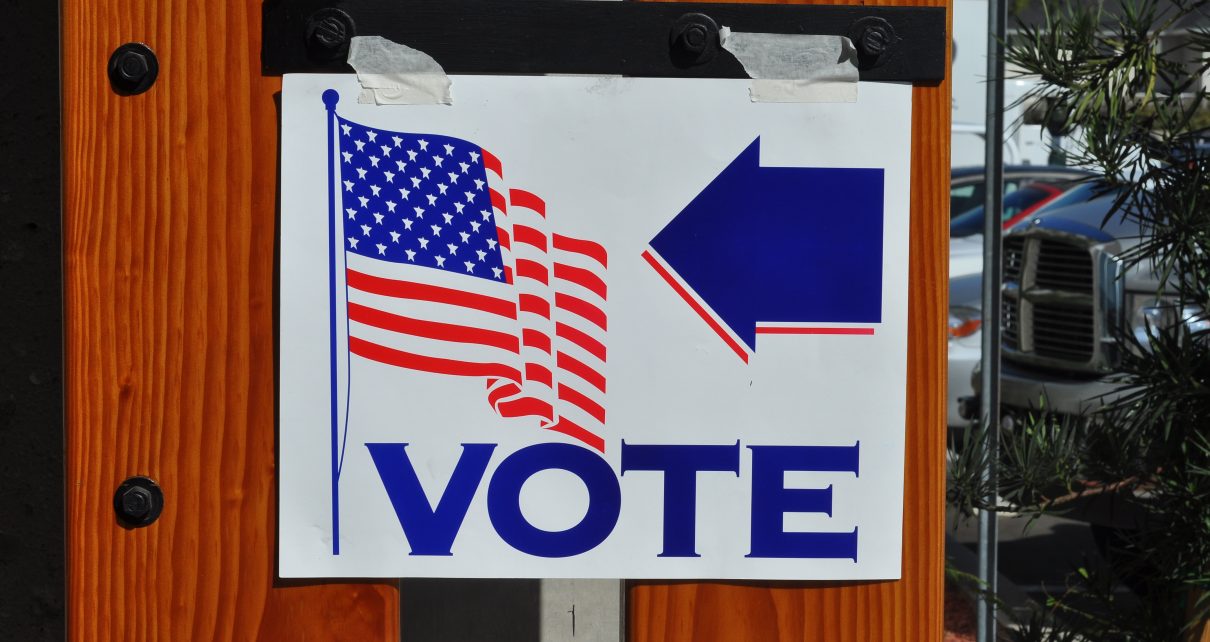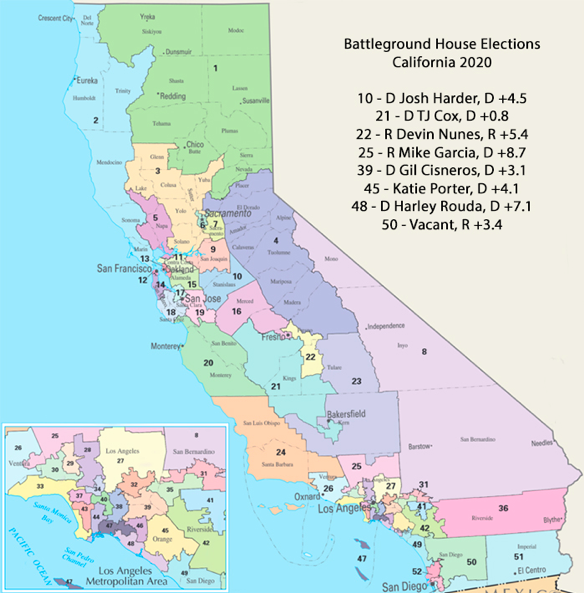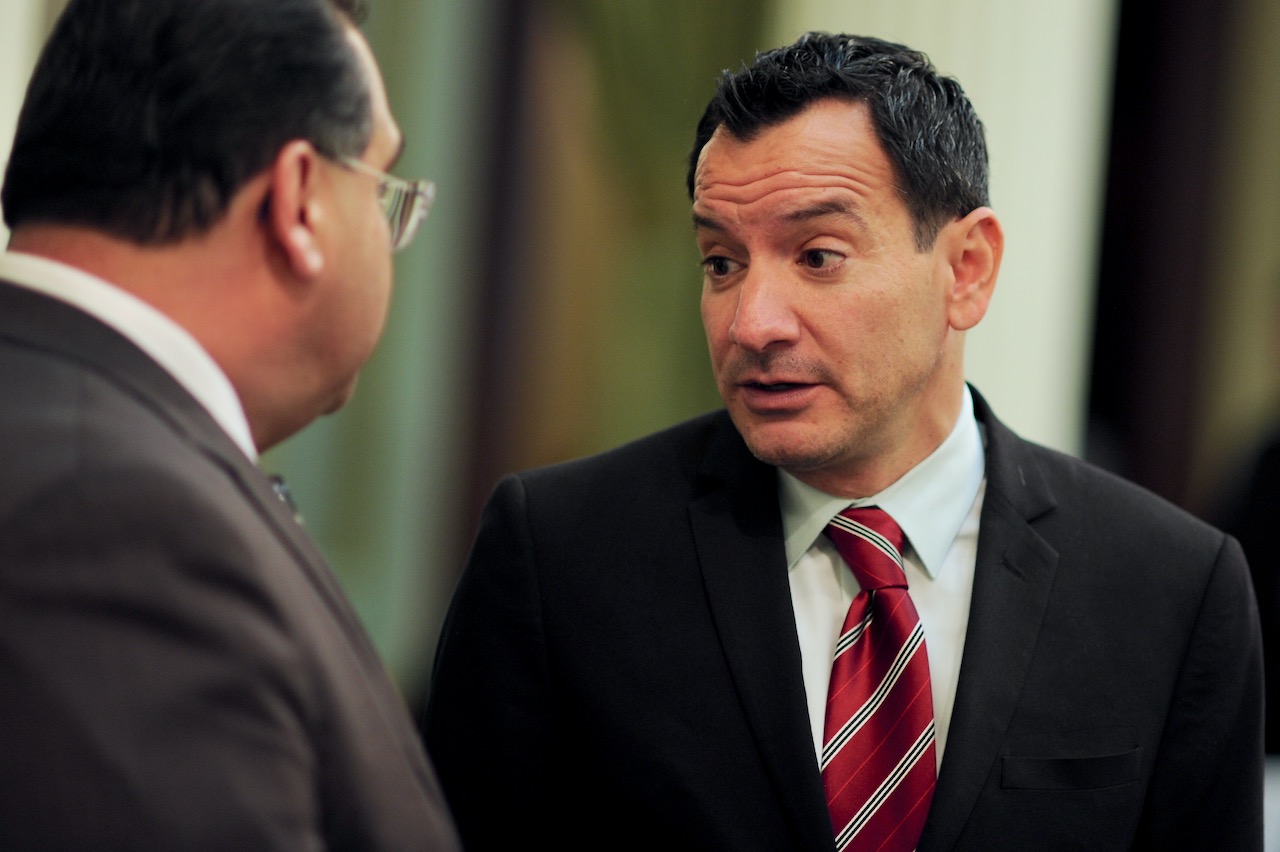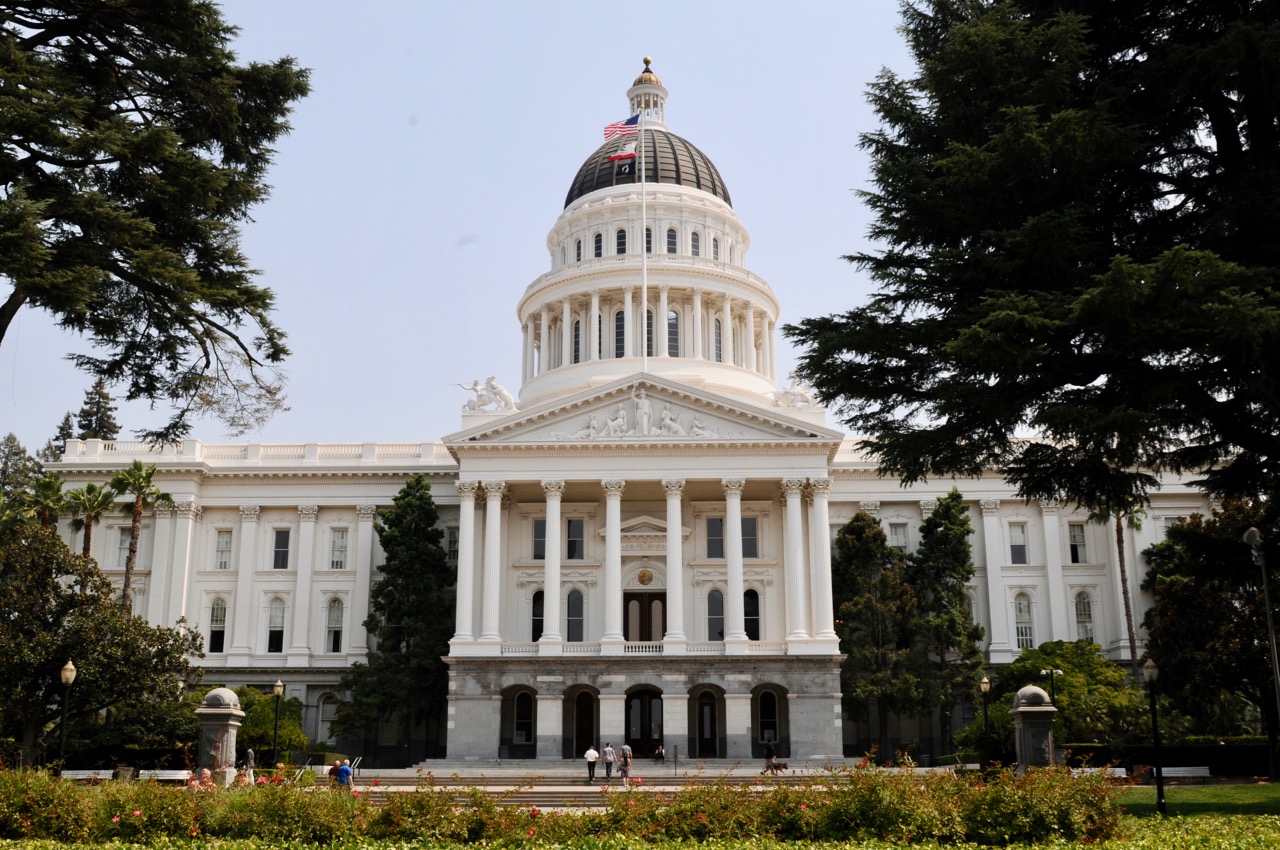
VOTE sign. (Photo: Wikipedia)
Let the Children Vote – Prop. 18 Lowers Voting Age
The partisan agenda of California’s teachers’ unions affects what students learn and their political opinions
By Edward Ring, August 26, 2020 6:17 am
What else do we know about this population 18 to 24? They are stupid. That is why we put them in dormitories. And they have a resident assistant. They make really bad decisions.
– Kamala Harris, excerpt from speech to Ford Foundation, 2014
If only Kamala Harris, and like-minded proponents of California’s Prop. 18, had the courage of these convictions. Kamala Harris may have been sincere, but political objectives often override common sense. Prop. 18, which will permit anyone who turns 18 by the next general election to vote in special elections or primaries prior to that general election, is a nakedly partisan ballot proposition. It is based on the fact that California’s youth are even more likely to lean Democrat than California’s adult voters, and is therefore calculated to pad Democratic voter registration in order to swing what few battleground districts remain in deep blue California.
Statistics are readily available to prove this assertion. For starters, view the results so far of the “pre-registration” campaign targeting 16 and 17 year olds, initiated by Secretary of State Alex Padilla, a Democrat. The program, initiated in 2016, started out slowly, with only 90,000 teens pre-registered as of March 2018. But by September 2018 that number was up to 200,000, and a year later, it passed 400,000. In time for the March 2020 primaries, as Padilla’s office triumphantly disclosed in a February 6, 2020 press release, it passed 500,000. The party preferences among these pre-registrants skew sharply Democrat, even for California.
Young Voters Vote for Democrats
As shown on the report issued by California’s Secretary of State “Total Pre-Registrations by Political Party as of 2/3/2020,” Democratic pre-registrants, at 39.1 percent, are nearly four times as numerous as Republican pre-registrants, at 11.7 percent. This compares to statewide registration of eligible voters in 2020 showing Democrats, at 44.6 percent of registrants, not even managing a two-to-one advantage over Republican registrants at 23.7 percent.
This strategy becomes more evident when overlaying the party preferences of pre-registrants by county with battleground congressional districts. The map shown below depicts California’s U.S. Congressional Districts, with eight battlegrounds identified. A few examples should suffice to illustrate the strategic value to Democrats of an expanded youth vote.
Consider the location of District 21, where Democrat TJ Cox upset Republican David Valadao by a mere 862 votes in 2018. This district encompasses portions of Fresno, Kings, Tulare, and Kern counties. The pre-registered young Democrats in those four counties as of February 2020 (which means most of them will be eligible to vote this November) numbered 9,857, whereas the preregistered Republicans numbered barely more than half that many, at 5,349. Not all of these voters reside in the 21st Congressional District, of course, but similar patterns apply in all counties.
For example, Orange County, once considered California’s impregnable bastion of Republican power, is now up for grabs. Two U.S. Congressional Districts – District 45 and District 48 – were long considered safe Republican seats, but in 2018 were won by Democrats. In what promise to be two very close congressional races this November in Orange County, 15,448 young Democrats are pre-registered as of February 2020, compared to only 6,970 young Republicans.

There is abundant evidence that the youth vote disproportionately belongs to Democrats, even in a state where the general electorate is disproportionately registered as Democrats. The Public Policy Institute of California released a study last year summarizing the result of surveys they conducted between Sept. 2018 and July 2019 on California voter preferences. Their findings, as reported by the San Francisco Chronicle, found that among likely voters, 52 percent of Millennials are registered Democrat, compared to only 43 percent of Generation X and only 44 percent of Baby Boomers. Time, along with demographics, appears to favor Democrats.
Based on this evidence, the partisan political objective behind Prop. 18 is clear. But what about the hard truths? Are people aged 18 to 24 really “stupid,” as Kamala Harris has said?
Is Kamala Harris Right? And If So, Should Children Vote at Age 17?
There’s two aspects to this question. First, what characteristics differentiate the average brain of a 17 year-old from someone, say, 25, and do those differences matter when it comes to voting? Second, what are the primary influences on someone age 17 – for example, the teaching environment in their public school, and do those differences matter when it comes to voting?
To the first question, there is no longer any scientific uncertainty that the human brain continues to develop until age 25. Twenty five. A 2013 report in the journal Neuropsychiatric Disease and Treatment entitled “Maturation of the adolescent brain” includes the following assertions:
“It is well established that the brain undergoes a “rewiring” process that is not complete until approximately 25 years of age,” and “Neuroimaging studies have revealed that when interacting with others and making decisions, adolescents are more likely than adults to be swayed by their emotions.”
This study examines the biomarkers influencing brain function and ticks through an impressive array of neurobehavioral evidence. Its conclusions are unambiguous.
“The prefrontal cortex offers an individual the capacity to exercise good judgment when presented with difficult life situations. The prefrontal cortex, the part of the frontal lobes lying just behind the forehead, is responsible for cognitive analysis, abstract thought, and the moderation of correct behavior in social situations… The prefrontal cortex is one of the last regions of the brain to reach maturation. There are several executive functions of the human prefrontal cortex that remain under construction during adolescence. The fact that brain development is not complete until near the age of 25 years refers specifically to the development of the prefrontal cortex… The development of the prefrontal cortex is very important for complex behavioral performance, as this region of the brain helps accomplish executive brain functions.”
This 2013 study is not an outlier. As a matter of fact, the idea that members of the 18-24 age cohort are not full fledged adults is now the conventional wisdom. Referencing a Harvard study on this question, and referring to people in their late teens and early twenties, a New York Times article announced in 2016 “You’re an Adult. Your Brain, Not so Much.” You can go back to 2009 for a study summarized in the Journal of the American Psychological Association: “While Adolescents May Reason As Well As Adults, Their Emotional Maturity Lags, Says New Research.”
If you’re between the ages of 18 and 24, you’re stupid. Corroborating material is plentiful. The Wall Street Journal reports in a 2012 article; “Delayed Development: 20-Somethings Blame the Brain.” The BBC, just last year, citing Cambridge University researchers, reported “People don’t become ‘adults’ until their 30s, say scientists.” There’s literally nothing from the scientific community that contradicts Kamala Harris – here are more concurring reports from Scientific American and Psychology Today.
Who Forms the Political Sentiments of California’s Teenagers?
It doesn’t take a scientific study to know that the younger someone is, the less life experience they have. Without the base of knowledge and experiences and relationships built up over years and decades, teenagers are more likely to be heavily influenced by what they’re taught and by what their peers and role models believe. Our scientific knowledge of the adolescent brain merely adds a compounding factor – young people up to the age of 25 have not yet reached their innate potential to perform cognitive analysis and abstract thought, or resist being swayed by their emotions.
Which brings us to the question of California’s public schools, and how the partisan agenda of California’s teachers’ unions affects what students learn and how they form their political opinions.
The most powerful union in California is the California Teachers Association, with an estimated revenue in 2018 (local and state chapters combined) of over 350 million. The CTA, along with the smaller but also powerful California Federation of Teachers, is politically active and highly partisan. A quick scan through the CTA’s official website confirms this, revealing their positions on standardized testing, “alternative discipline,” charter schools (“Kids Not Profits”), immigration, and a host of “social justice” issues.
One powerful local teachers union in California that has been loosely affiliated with both the CTA and the CFT is the United Teachers of Los Angeles, representing teachers in the second largest school district in the United States. The agenda they have put forward to cope with the COVID-19 pandemic provides a representative example of the political mentality of California’s K-12 public school teachers’ unions.
Included in the UTLA’s demands in this time of economic and medical crisis are things that have little to do with those issues, which one would think are broad enough and challenging enough to be addressed without distractions. But UTLA’s laundry list, entitled “Safe and Equitable Conditions for Starting LAUSD in 2020-21,” constitutes a comprehensive political agenda.
At the federal level, the UTLA is calling for federal assistance including an emergency bailout, along with increased Title I funding, increased Individuals With Disabilities Education funding, and “Medicare for All.”
At the state level, UTLA is calling for passage of the proposed property tax increase that is already on the November ballot, along with a “Wealth Tax” of 1 percent a year, and a “Millionaire Tax” of up to 3 percent surtax on high-income Californians.
And at the local level, UTLA wants to “Defund Police,” provide free housing to anyone, ten additional sick days for all private employees, a moratorium on charter schools, and “financial support for undocumented students and families.”
The Teachers Union is Forming the Minds of Young Voters
The indoctrination of K-12 public school students in California and across much of the rest of the United States significantly pre-dates the COVID-19 crisis. An August 2020 Heritage Foundation commentary by Douglas Blair entitled “I’m a Former Teacher. Here’s How Your Children Are Getting Indoctrinated by Leftist Ideology,” offers further examples.
Blair describes how “the left uses a combination of propaganda and suppression to push kids into the ensnaring grip of socialism and anti-patriotism.” This propaganda includes “instilling the idea that the pillars of Western civilization were evil, and their memories deserve to be thrown in the trash.” In practical terms, for example, this means that on one hand Winston Churchill is a racist scumbag, and on the other, nothing relating to Black Lives Matter can be criticized.
Back here in California, a good example of leftist indoctrination promoted by the teachers unions is the proposed “ethnic studies” course that is closer than ever to being a mandatory requirement for high school graduation. This course might have already become part of California’s mandated curricula except for the fact that in its first version, it didn’t emphasize enough victimized groups. Jewish groups, joined by organizations representing Armenians, Greeks, Hindus and Koreans, were successful in sending the designers of California’s ethnic studies syllabus back to the drawing board, presumably to add them to the victims matrix.
California’s population demographics have reached the point where barely over 10 percent of its public high school students are “non-hispanic white cis-heteronormative males.” Notwithstanding the trauma learning about “The Four ‘I’s’ of Oppression” might cause these privileged scions of pariahs, imagine what instilling this mentality does to the other 90 percent, who are all taught that they are “victims of oppression.”
What California’s public educators are doing, to the extent they are exposing their impressionable students to concepts and narratives that stir envy, resentment, guilt, shame, anger, revenge, along with a whole lot of just plain weird, is akin to cult manipulation. Depersonalize someone. Make them only exist as a member of a group. Invent an entirely new system of language and concepts to guide their thinking. Destroy their faith in outside institutions. Then prescribe the solutions.
And then make sure they vote.
- Ringside: EVs and California’s Future Demand for Electricity - December 4, 2025
- Ringside: Politically Viable Water Supply Projects - November 27, 2025
- Ringside: Shifting Costs Does Not Solve California’s Electricity Shortages - November 20, 2025





This title of this article is misleading.
17 year olds are basically Adults not kids.
I’ve been working hard to #LowertheVotingAgeto12 to #LetKidsVote for years & i believe Seattle Washington may be the 1st city to #LowertheVotingAgeto12!!
I made a video as to why kids should vote as young as age 12!!
This is a link to that video: https://youtu.be/96kw8gMGuuA
Republicans seem to hate respecting the voice of the Opressed?
Look at this since locked thread about teaching freaking out about parents learning what they are teaching. Think they wouldn’t tell kids how to vote?
https://archive.fo/Vgww5#selection-9121.0-9121.184
@ eternally 12
Basically anyone is or can be an ‘ adult ‘ that will vote democrat, correct? Or I suppose their parent can guide them on how to fill out the ballot ‘ correctly ‘ since democrats are desperate for votes to keep the corruption and destruction going that they benefit from. Anyone with a working brain can now clearly see what the democrats offer and it’s going to become more difficult to convince the electorate to vote for them. Allowing children to vote is just more voter fraud from the democrats who pretend to care.
Democrats seem to love oppressing others and especially those who do not agree with them.